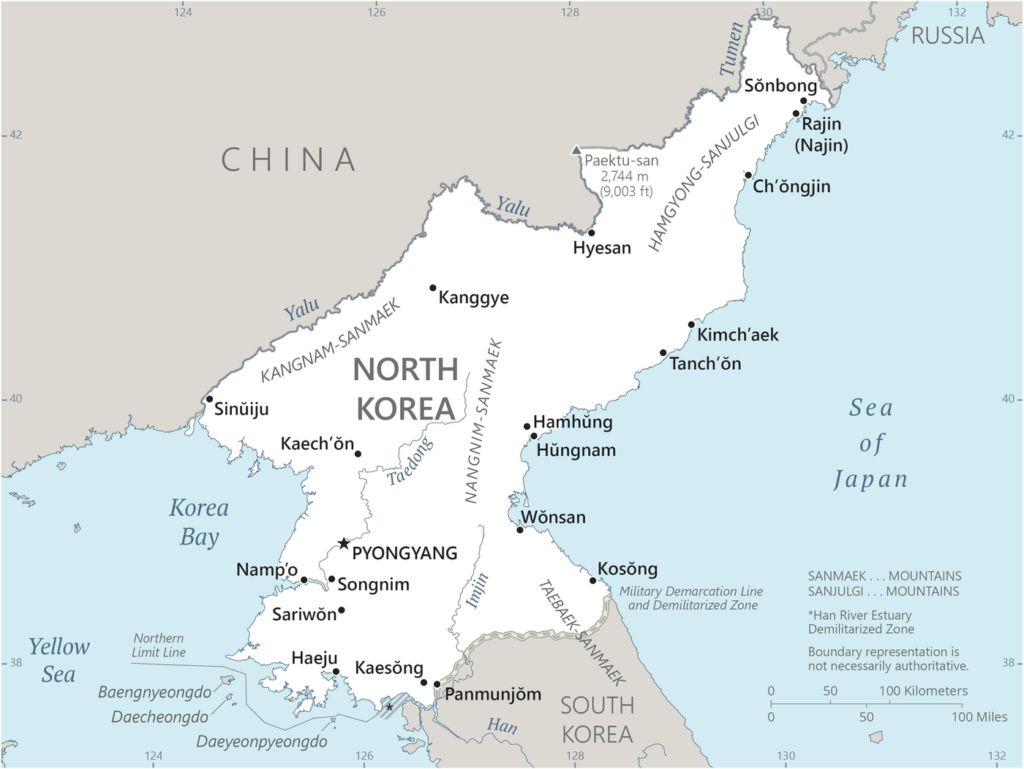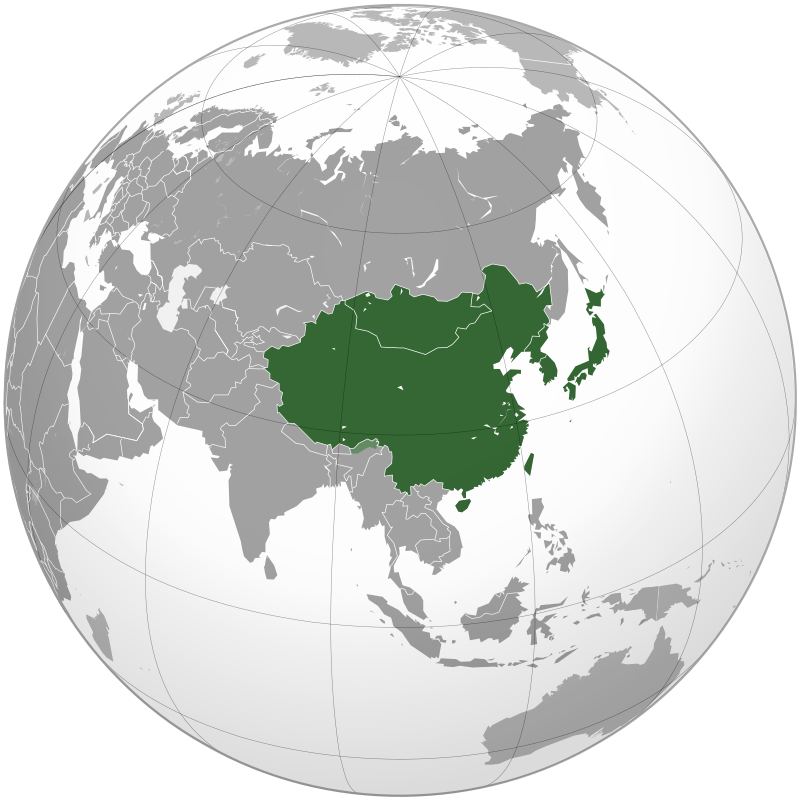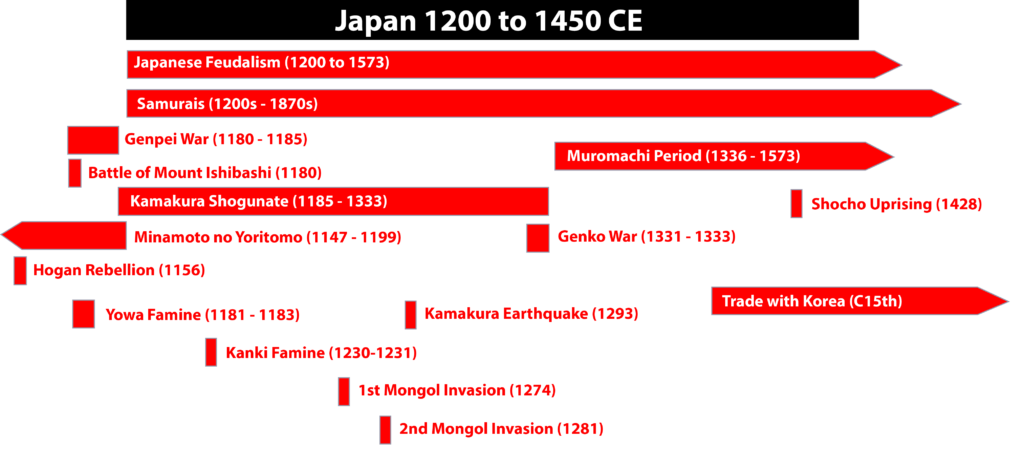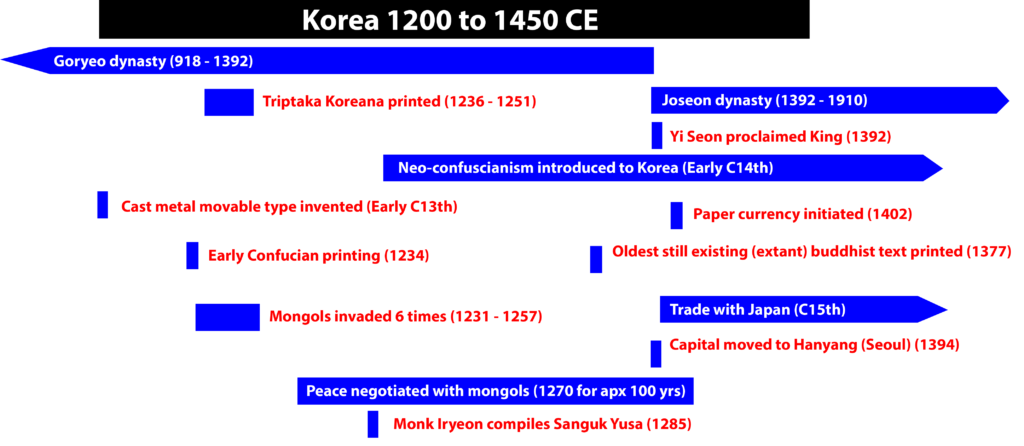Welcome to The Global Tapestry of East Asia Day – Korea and Japan
>Learning Areas
| Unit 2: The Global Tapestry (Population Patterns and Processes) |
| How states formed, expanded, and declined in areas of the world during the period c. 1200–c. 1450 |
| Patterns associated with human populations. |
| Population density and how it affects society and the environment |
| Theories of population growth and decline |
| Population and immigration policies and their effects |
Japan
>Shogunate
Watch the first minute.
>Death of the Historical Buddha (Nehan-zu)
“Facing westward in a final trance after a long life of teaching, the golden body of the Buddha bears the marks of his enlightened nature. Short curls covering his head indicate his ascetic life, while elongated earlobes adorned with heavy jewelry reflect his birth as a prince. A cranial protuberance and a circle of light between his brows attest to his penetrating wisdom.”
(from: https://www.metmuseum.org/art/collection/search/44841)
Take a look at the artwork and read more about it here.
>Burakumin
The Burakumin were a class of people who became untouchable during the feudal system of medieval Japan. Read more about them here.
>Japanese Landscape
Spend an hour of so in total zen, painting a simple and calm inducing Japanese landscape.
Examples on Pinterest
>Rising Sun – Video Tutorial
>Japan Dream Painting Tutorial
>Video Tutorial – Easy Sunset Painting
Korea
>Introduction
Korea is a peninsular region in East Asia.
The region consists of the Korean Peninsula, Jeju Island, and a number of minor islands near the peninsula. The peninsula is bordered by China (Manchuria) to the north and Russia to the northeast.
It is separated from Japan to the southeast by the Korea Strait.
The first state to emerge was Gojoseon, which fell to the Han Dynasty in 108 BC.
During the first half of the 1st millennium, Korea was divided between three states, Goguryeo, Baekje, and Silla, together known as the Three Kingdoms of Korea.
In the late 7th century, Silla conquered Baekje and Goguryeo with the aid of the Tang Dynasty, and drove the Tang out of Korea during the Silla-Tang War. Meanwhile, Balhae, formed by Goguryeo remnants and Mohe people, succeeded Goguryeo in the north. Unified Silla eventually collapsed into three separate states due to civil war, known as the Later Three Kingdoms.
Toward the end of the Later Three Kingdoms, Goguryeo was resurrected as Goryeo, which defeated the two other states and unified Korea as a single sovereign state. Around this time, Balhae collapsed and its last crown prince and much of its ruling class fled to Goryeo, unifying the two successor states of Goguryeo. Goryeo was a highly cultured state.
During the 13th century, the Mongol Empire made Goryeo its servant state after decades of war. Although Goryeo overthrew Mongol rule, it fell to a coup led by General Yi Seong-gye, who established Joseon on 17 July 1392.
The first 200 years of Joseon were marked by relative peace, and during this time the Korean alphabet was created by Sejong the Great and Confucianism became increasingly influential in the kingdom.
This ended with the Japanese invasions of Korea and the 1636, which brought great devastation to Joseon and lead to Korean isolationism. After the end of these invasions, Joseon experienced a nearly 200-year period of peace and prosperity, along with cultural and technological development. In Joseon’s final years, it experienced much turmoil in the forms of coups, revolutions, and assassinations.
In 1897, the Korean Empire was established to protect Korean independence. However, following Japan’s victories in the First Sino-Japanese War and Russo-Japanese War, Japan annexed it (made it part of Japan) altogether in 1910.
Since 1945, it has been divided at or near the 38th parallel, now known as the Korean Demilitarized Zone.
In 1948, two states declared independence, both claiming sovereignty over all of Korea: South Korea (Republic of Korea) comprising its southern half and North Korea (Democratic People’s Republic of Korea) comprising its northern half.
>Maps



>Goryeo
Goryeo was a Korean state founded in 918, during a time of national division called the Later Three Kingdoms period. Goryeo unified and ruled the Korean Peninsula until 1392, achieving what has been called a “true national unification” by Korean historians.
The name “Korea” is derived from the name of Goryeo.

>Joseon
Joseon, officially Great Joseon State, was the last dynastic kingdom of Korea, lasting just over 500 years. It was founded by Yi Seong-gye in July 1392 and replaced by the Korean Empire in October 1897.
The kingdom was founded following the aftermath of the overthrow of Goryeo in what is today the city of Kaesong.
Early on, Korea was retitled and the capital was relocated to modern-day Seoul.

>Cast Metal Movable Type
Movable type is the system and technology of printing and typography that uses movable components to reproduce the elements of a document, usually on the medium of paper.
The oldest extant book printed with movable metal type, Jikji, was printed in Korea in 1377 during the Goryeo dynasty.
Movable type for book printing in East Asia evolved from three materials: wood, clay (which was little used), and ultimately a cast-metal system that was developed fully in Korea where the extraordinary cost of casting bronze type was borne by the government. This medium permitted quick printing so, for example, the state printing office could produce approved texts from metal type for rapid distribution to provincial officials who then ordered woodblocks to be cut for broader distribution. The blocks could then be preserved for later reprinting.
The 13th century Tripitaka Koreana, an extensive collection of Buddhist scriptures carved onto the face of 81,258 wooden printing blocks, remain housed today in a light, airy building in the Haeinsa Monastery in southwestern Korea. Even now, after 775 years, these woodblocks can be employed to print a crisp, complete reproduction of the Tripitaka.

(from: https://jikji.utah.edu/#:~:text=Movable%20type%20for%20book%20printing,was%20borne%20by%20the%20government.)
>Vegan bibimbap
Bibimbap is a Korean rice dish. The term bibim means “mixing” and bap is cooked rice. It is served as a bowl of warm white rice topped with namul and gochujang.
Namul refers to either a variety of edible grass or leaves or seasoned herbal dishes made of them.
Gochujang or red chili paste is a savory, sweet, and spicy fermented condiment popular in Korean cooking.
Plan to make a bibimpap. You are going to buy the ingredients and prepare the meal.
Note: It’s a lot like a poke bowl and there’s a good reason for this. Think about why this might be.
Take Photos!
Which Medieval East Asian Country are You Suited To?
Which medieval East Asian country would have suited you best?



